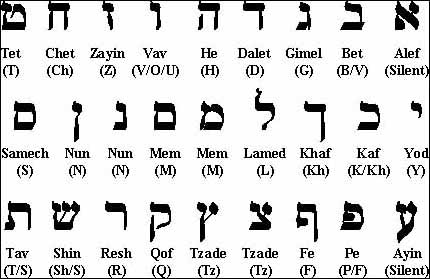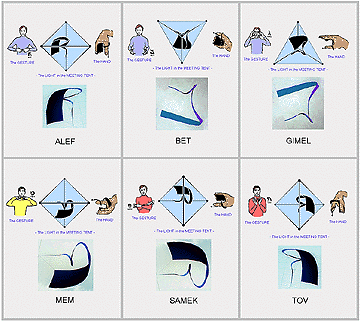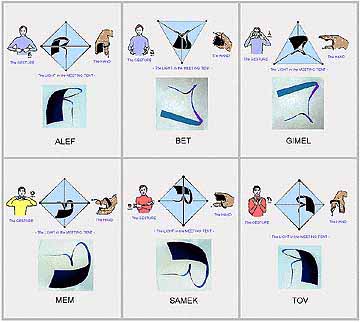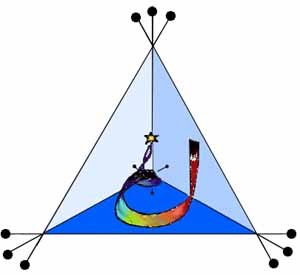

The Hebrew alphabet is either of two distinct Semitic alphabets - the Early Hebrew and the Classical, or Square, Hebrew. It is written from right to left, rather than left to right as in English, so Alef is the first letter of the Hebrew alphabet and Tav is the last. The Hebrew alphabet is often called the "alefbet," because of its first two letters.
There are two versions of some letters. Kaf, Mem, Nun, Pe and Tzade all are written differently when they appear at the end of a word than when they appear in the beginning or middle of the word. The version used at the end of a word is referred to as Final Kaf, Final Mem, etc. The version of the letter on the left is the final version. In all cases except Final Mem, the final version has a long tail.
Like most early Semitic alphabetic writing systems, the alefbet has no vowels. People who are fluent in the language do not need vowels to read Hebrew, and most things written in Hebrew in Israel are written without vowels. However, the rabbis realized the need for aids to pronunciation, so they developed a system of dots and dashes called n'kudot (points). These dots and dashes are written above or below the letter, in ways that do not alter the spacing of the line. Text containing these markings is referred to as "pointed" text.
Some Hebrew letters have two pronunciations. Bet, Kaf, and Pe have a "hard" sound (the first sound) and a "soft" sound (the second sound). In pointed texts, these letters have dots in the center when they are to be pronounced with the hard sound.
The style of writing commonly seen in Hebrew books. It is referred to as block print or sometimes Assyrian text. For sacred documents, such as torah scrolls or the scrolls inside tefillin and mezuzot, there is a special writing style with "crowns" (crows-foot-like marks coming up from the upper points) on many of the letters. This style of writing is known as STA"M (an abbreviation for "Sifrei Torah, Tefillin and Mezuzot," which is where you will see that style of writing. For more information about the STA"M alphabet, including illustrations and relevant rules, see Hebrew Alphabet used in writing STA"M.
The process of writing Hebrew words in the Roman (English) alphabet is known as 'transliteration'. Transliteration is more an art than a science, and opinions on the correct way to transliterate words vary widely. This is why the Jewish festival of lights (in Hebrew, Chet-Nun-Kaf-He) is spelled Chanukah, Chanukkah, Hanuka, and many other interesting ways. Each spelling has a legitimate phonetic and orthographic basis; none is right or wrong.
Early Hebrew was the alphabet used by the Jewish nation in the period before the Babylonian Exile--i.e., prior to the 6th century BC--although some inscriptions in this alphabet may be of a later date. Several hundred inscriptions exist. As is usual in early alphabets, Early Hebrew exists in a variety of local variants and also shows development over time; the oldest example of Early Hebrew writing, the Gezer Calendar, dates from the 10th century BC, and the writing used varies little from the earliest North Semitic alphabets.
The Early Hebrew alphabet, like the modern Hebrew variety, had 22 letters, with only consonants represented, and was written from right to left; but the early alphabet is more closely related in letter form to the Phoenician than to the modern Hebrew. Its only surviving descendant is the Samaritan alphabet, still used by a few hundred Samaritan Jews.
Between the 6th and 2nd century BC, Classical, or Square, Hebrew gradually displaced the Aramaic alphabet, which had replaced Early Hebrew in Palestine. Square Hebrew became established in the 2nd and 1st centuries BC and developed into the modern Hebrew alphabet over the next 1,500 years. It was apparently derived from the Aramaic alphabet rather than from Early Hebrew but was nonetheless strongly influenced by the Early Hebrew script.
Classical Hebrew showed three distinct forms by the 10th century AD: Square Hebrew, a formal or book hand; rabbinical or "Rashi-writing," employed by medieval Jewish scholars; and various local cursive scripts, of which the Polish-German type became the modern cursive form.
| 0. Fool | Aleph | Bull / Ox | Age of Taurus |
| 1. Magician | Beth / Bet | house | location |
| 2. High Priestess | Gimel / Gimmel | camel | means of transportation |
| 3. Empress | Daleth / Dallet | door | passage through / womb |
| 4. Emperor | Heh | window | letting in light |
| 5. Heirophant | Vav / Vau / Vahv | nail / hook | joins parts together |
| 6. Lovers | Zain / Zayin / Zy-in | sword | cuts / discrimination |
| 7. Chariot | Cheth / Chet | the fence enclosing enclosing a field |
home |
| 8. Strength | Teth / Teht | snake | source of illusion / reincarnation |
| 9. Hermit | Yod / Yud | open hand | power |
| 10. Wheel of Fortune | Kaph (a curve) | closed hand | to hold on to |
| 11. Justice | Lamed / Lahmed | ox-goad / to teach and instruct / education Justice is not blind! |
goads Aleph |
| 12. Hanged Man | Mem / Mehm | sea | birth |
| 13. Death | Nun | fish | to sprout and grow / fertility |
| 14. Temperance | Samekh / Sah-mech | tent peg | upholds |
| 15. Devil | Ayin / Eye-in | eye / foundation | seeing appearances only |
| 16. Tower | Peh | mouth as the organ of speech / the power of utterance |
speech / talking |
| 17. Star | Tzaddi / Tzah-dee | fish hook | draws #13 fish out of #12 water |
| 18. Moon | Qoph / Koph / Ooph | back of head | discernment / thought |
| 19. Sun | Resh | face of man | countenance |
| 20. Judgement | Shin | tooth | serpent’s fang / the Holy Letter (refers to #8) |
| 21. World | Tav / Tau / Tahv | signature / mark | salvation |

According to Stan Tenen of the Meru Foundation, these gestures and the position of "The Light in the Meeting Tent" will yield these specific letters.
By fusing mathematics and Jewish mysticism, Tenen has demonstrated that the first verse of Genesis in the Hebrew Bible generates a mathematical Torus. When a particular portion is removed from this 'doughnut', its shape mirrors the human hand.
Tenen claims the Hebrew alphabet is based on the human hand, because it represents the function of differentiating self from other, inside from outside. "The alphabet links the inner world of the mind with the outer world of experience, just as our hands do," he says. "And," he continues, "The first letter of the book of Genesis -Bet- means 'house', something that distinguishes inside from outside; this is the most basic distinction you can make at any level of consciousness."
When Tenen broke the first word of Genesis into its 'subatomic particles' (the word is actually comprised of two smaller words, meaning "fire" and "six-edged thorn"), he took the "thorn" to mean a tetrahedron and constructed a model of it, placing the "fire," or torus "vortex" form, inside.
Tenen noticed that the model, which he calls "The Light In the Meeting Tent" also reflected the polarity of perfect symmetry (the tetrahedron) and asymmetry (the vortex form). As he studied it, he discovered it was even more multifaceted than he had realized. "When I looked through the faces of the tetrahedron at the vortex, each view displayed a different letter in the Hebrew alphabet," he says. And," he mentions almost casually," I realized the 27 gestures that accompany the letters correspond to the 27 'preferred' pointing directions used in hyper-dimensional space."
He says the Hebrew Bible is arranged similarly to a hologram: the first letter contains the whole, the first word expands on the first letter, the first sentence upon the first word, etc. "It's very much like what our scientists do," he says. "We include information with messages sent to outer space that explains how to decode the entire message-that's also how compression programs work on computers." He also believes the Hebrew Bible contains a function similar to the mathematical purpose of pi, and links consciousness and physicality the way pi links the radius and circumference of a circle: "Our radius is our physicality and the circumference is our life, our emotions," he says. "The ancient Hebrew alphabet is far more than a tool for everyday communication or the transmission of sacred texts; the letter forms themselves have intrinsic geometric and mathematical properties that point us to a profound knowledge of life and the nature of human consciousness."
Tenen feels there are principles of law and order in the relationship between humans and the cosmos that, up till now, only Pythagoreans and Kabbalists have suspected. "What I've found," says Tenen, "is that these principles correspond to the numerical patterns of some of the basic geometrical forms found in the physical world. For example, the double helix, which is the form of the DNA molecule."
Born in Newark, NJ in 1942, Tenen grew up in Brooklyn, NY in a nonreligious Jewish family. A shy child, he describes himself as having been "afraid of the world" and "socially backwards." He remembers watching his mother play solitaire and do card tricks ("which," he says, "became very significant to me later in life"). He joined the math team in high school, where he found "elegant problems in geometry and algebra on the board." "It was," he says, "a speed crash course in math, a drill for pattern recognition. It was very intuitive-you would size it up from all directions and jump to the answer."
Tenen attended Brooklyn Polytech and earned a BS in physics, eventually working as a senior physicist for Block Engineering in Cambridge, Mass., a company known for manufacturing an interferometer which could be used as a spectrometer. There he gained practical knowledge of the Fourier transform, which added another piece to his life's work. A 1967 trip to Jerusalem became a turning point in his life: Standing in front of the western wall of the Temple, the 'scientist with no particular connection to religion' was moved by a scene he describes as 'surreal'-'Palestinians looking very humiliated and Israeli police looking very threatening-I spontaneously started crying and prayed that if there was anything I could do to help, let me know."
After his return to the US, Tenen saw an episode of CBS's metaphysical spin-off of Secret Agent, called The Prisoner. Originally a BBC production, the episode was about a secret code; it piqued his interest and sent him searching for a copy of the Bible. "I found one my neighbor had given me when I'd been Bar Mitzvah-hadn't opened it since," he laughs. He turned to the first page of Genesis and, not knowing the Hebrew language, his eyes fell on the letters rather than the words. "I was suddenly back at the math lab, seeing a pattern, and I realized it was very similar to the way my mother had woven the deck of cards," he says.
Over the next ten years, Tenen investigated a potential biblical code; he bought nearly 3,000 books on sacred traditions-Hebrew, Christian, Moslem, academic, occult and even channeled material. In 1978 he and his wife, Cynthia moved to San Francisco, where PBS aired The Prisoner series on TV. The Tenens offered to do an impromptu live wraparound for each episode: "When the episode with The Code came along," says Tenen, "I realized the audience was mostly open-minded college students, so I held up the first line of the Hebrew text of Genesis and told them it was a legitimate communication, but didn't tell them it was from the Bible."
Tenen then invited the audience to participate in deciphering the code. He received many interesting suggestions, but the breakthrough came when students from a local high school suggested he try counting in base-3. "As soon as I counted the Hebrew letters in base-3," he says, "they paired up-it was like a bolt of lightening-like a TV screen coming into focus. I put each letter on a bead in the order of the text of Genesis and curled it around until the same letters or those that were mirror images in base-3 matched up. I made the most compact arrangement possible, and a beautiful, toroidal pattern emerged."
Convinced he was onto something, Tenen began searching for a way to fund further research. Still painfully shy, he forced himself to go to cocktail parties, "so I could meet influential people in the community"' in 1983 he met John Keeler, who helped organize the Meru Foundation, which Tenen has directed ever since. They chose the name Meru because it encompassed a wide spectrum of spiritual concepts, including Tomera, a name for the Cheops Pyramid; Sumeru, a Hindu name for the Pascal Triangle; Mt. Meru (said to connect heaven and earth); and Meruba, the name of the Hebrew alphabet.
In 1986, Tenen realized the patterns he had found meant that the text of Genesis "literally folds itself up into a model which generates the letters in which it's written, and does so in such a way that you can read the text as a meditational dance. The Hebrew Bible can be seen as the template of creation. We should expect to find the same patterns in the Bible as we find in the real world," he says. "The ancients studied the patterns in the heavens-I began to think, 'What would happen if you could map the patterns of the temples of the heavens onto the temples of your mind?' The patterns in the Hebrew Bible are the same as those in the heavens; when you chant regularly you are weaving these patterns onto your mind, internalizing the patterns of the universe-stepping out of your skin to have an ego-death experience."

According to Tenen these gestures and the position of "The Light in the Meeting Tent" will yield these specific letters.
Tenen has explored history using his theories and has found the same pattern again and again. "For example," he says, "You find it in Rumi's poem describing the Sufi Round Dance, in the Philippine Wine Dance (where you hold a wine glass in your palm and rotate it above and below your shoulder-the old Cleopatra dance), in the Grail Legend material, in William Blake's poetry, the Celtic Odin stories, in the weaving and basketry of Amerindian peoples and, literally, in every culture the world has ever seen"
His work bears some relation to the mystical Jewish practice of gematria, which finds hidden meanings in the numerical equivalents of the Hebrew alphabet. It also bears resemblance to the work of the best-selling author Michael Drosnin; Tenen, however, is quick to point our major distinctions between the two: "My explanation doesn't include any Nostradamus-like predictions," he states. "The key difference is that the Nostradamus stuff claims the Bible contains prophecy; whereas my work claims the Bible contains exercises that a qualified individual can use to attain a state of prophecy." He further distances himself from the popular work by stating that he finds the prediction of names, dates, or historical events (notably, Yitzhak Rabin's assassination) "a misinterpretation of data."
Though he has a degree in physics, holds numerous patents, has produced optical and electronic equipment for doctors and surgeons, and can visualize complex concepts in four dimensions as fast as computers at the University of Minnesota's Center for Geometry, Tenen claims that his only credential is integrity. He strives to be 'morally transparent'-the same on the inside as on the outside. "We have to remember," he says, "that the math is only a map; our feelings and experiences are the territory."
To achieve moral transparency, Tenen began incorporating Orthodox rituals into his daily schedule a number of years ago, doing so with some effort "out of respect for the well from which I had been drinking for so long." In honoring the source, Tenen unexpectedly discovered something that had eluded him for years-the exact shape his vortex model should be. "I put on the tefillin during morning prayers-you wind a strap on your hand and you're supposed to see the Hebrew letters-it hit me immediately that my 'vortex form' was a model of the human hand, preserved through tradition of tefillin," he says.

he "Meru flame letter" in a tetrahedron is what Tenen refers to as the "Light in the Meeting Tent." The version shown here was drawn in 1986 and has since been refined to the version shown at the head of this article.
Though the realization was an instantaneous 'Aha!', it took him years to mathematically perfect the shape of the hand model, which incorporates fourteen explicit features representing aspects of western philosophies and is based on a spiral used in art throughout the ancient world, most notably under the Egyptian 'Eye of Horus.' "It is not the Golden Spiral," he says. "The golden spiral is a modern invention that circles itself endlessly in its own image-philosophically, it denotes narcissism.
True sacred geometry appears like the golden spiral for quite a while and then it straightens out." "Like the Egyptian spiral," he continues, "ours has a tightly coiled part which expands into all there is-the coiled part represents the human head and brain and the straight part, the spine...if you overlay the spiral over a human embryo at 56 days, they match perfectly."
Tenen uses many materials to make these model sculptures: metal, plastic, leather and "things from the flea market"' high-tech versions are supplied via computer printout. "To make the hand model for yourself," he suggests, "put on latex gloves and draw it."
While Tenen emphasizes that his is a work-in-progress that must eventually be subjected to rigorous review within the scientific community, he believes it has value in scientific, philosophical and spiritual studies, and has implications for bridging cultural barriers and enhancing global communication.
Some within the Jewish community see its importance as equal to or greater than the discovery of the Dead Sea Scrolls. As a reporter for the Jewish Press stated, "it may not always be easy to follow Tenen's ideas; however, it is amazing that this man, once completely ignorant of Jewish tradition, has made discoveries which could represent the beginnings of a major breakthrough in the study of Kabbalah, consciousness, physics, and cosmology."
Tenen's work has also gained attention from a broad spectrum of mathematicians, theoretical physicists and philosophers. He notes wryly that it is sometimes seems " 'too Jewish' to non-Jewish audiences, 'too Christian' for my Jewish friends, 'too mathematical' for my religions friends, and 'too religious' for my scientific friends." Yet, if Tenen could sum up in a sentence what he would like his work to convey, it would probably encompass the idea of unity within diversity.
He puts it this way: "Like each of the letters of the alphabet, each culture has a vital contribution to make to the ecology and survival of the planet. The model found in the Hebrew text of Genesis is intrinsic to human consciousness-a science of consciousness like pi, not owned by anybody. The meditational dance has been preserved intact; it shows us how we can relate to each other in an elegant, coherent manner. This is truly a tree of life for those who grasp it."
Hebrew Languages Wikipedia